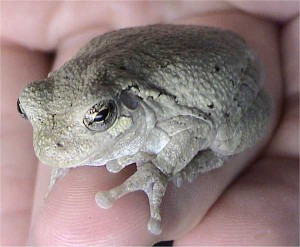Ever since a colleague introduced me to the Spadefoot Toad and the practice of monitoring frog and toad calls during the summer months as one way of tracking the prevalence and health of frogs and toad populations over time, I have been intrigued by any research on frog and toad calling. So, when I saw news headlines about “multitasking” Copes grey treefrogs (Hyla chrysocelis) and their “popularity” among the females of their species, I couldn’t resist.
The paper, published in Animal Behaviour by Ward and colleagues describes an investigation of the predictions of the “multitasking hypothesis”. Briefly this hypothesis predicts two things. The first prediction states that when you have a signal that has components that negatively covary (in order for one component to occur the second one is reduced), say pitch and volume, there will be a tradeoff between the two things (e.g., I can sing at a really high pitch, but not very loudly). The second prediction is that the individual on the receiving end of this signal is going to prefer the individual who can do both at the same time (e.g., sing at a really high pitch, very loudly). In this study, the authors looked at female frog choice based on three factors: call rate (the number of calls per minute), call duration (number of pulses per call) and call effort (calls/min x pulses/call = pulses/min). They asked two questions: Is there a tradeoff between rate and duration, and do female frogs prefer the male frogs that exhibit the higher overall “call efforts”?
Continue reading “Extreme Frog Calling: More Effort Equals Greater Interest”
